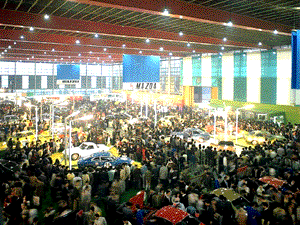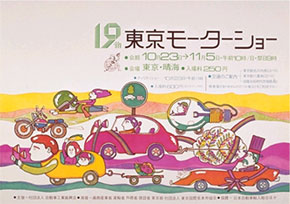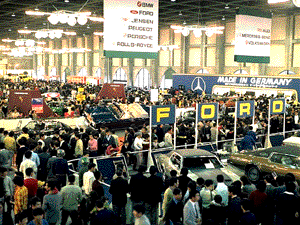 |
 |
 |
The
19th Tokyo Motor Show (1972
. 10/23 - 11/5)
 |
 |
| The 19th Tokyo Motor Show Poster |
A motor show is a good reflection of the motorization
of the times: sometimes new models, sometimes, motor sports
or dream cars are featured. A little differently, this
show featured "technology for safety and anti-pollution."
Consequently, the layout of the show halls was greatly
changed. Again, there was no exhibition of large commercial
vehicles. Small commercial vehicles, motorcycles, and
automotive parts occupied Hall 1. Passenger cars, facing
safety and pollution problems, were assigned to Hall 3.
Furthermore, one hall was assigned for safety and pollution
problems. This was a good indication that the auto industry
was tackling these problems with all its technological
energies. |
 |
 |
Behind this change of attitude was the fact that automobile accidents and pollution developed into major social problems as more emphasis was being placed on living environment. Especially this time, control of emissions to cope with the photochemical smog problem became a major exhibition. The JMIF worked not only to establish a common exhibition corner for environmental protection, but also to advise each exhibitor on providing such a corner of its own.
Accordingly, the exhibitors actively dealt with safety and environment issues, publicizing a wide range of technologies worth observing. The industry s status quo, and results of technological development were fully displayed: Honda s "CVCC," which aimed to clean emissions within the engine itself, Mazda s "RE Anti-Pollution system," "Catalytic Converter Systems" by Nissan, Mitsubishi and Fuji Heavy Industries, Toyota s "Oxide Catalytic Converter" to target hydrocarbons and carbon monoxide, and the display and illustration of "various thermal reactors" by Daihatsu.
Despite all the talk about pollution, however, there were few who visited the safety & environment pavilion. Although 80% of the visitors said they were interested in these subjects, only half of them entered the pavilion.
Visitors interests were elsewhere. For example, at "Beauty before vehicle," Nissan s Miss Fairlady. Use of professional models had been banned a few years before, but now the beauty was brought back, and crowds gathered. The lunar vehicles co-exhibited by GM and Isuzu, and Mitsubishi s replica of a 1917 Model A also attracted much attention. Conspicuous in the Passenger Car Hall were the Skyline GT racing car, the Mitsubishi Colt F-2 engine, the Isuzu R6 Spider, the Mazda Savanna racer, the Suzuki Vickr, and the Toyota Town Spider.
Since this show was mainly about safety and environment, the number of exhibits was decreased from 755 at the previous show to 559. The number of visitors also decreased to 1,261,400.
|
 |
|
|
|